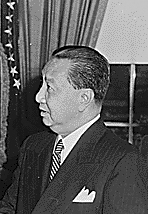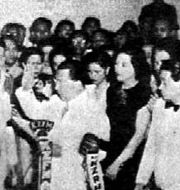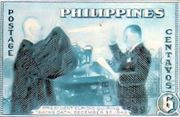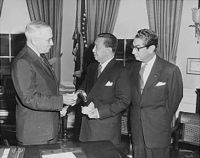Elpidio Quirino
| Elpidio Quirino | |
 |
|
|
|
|
| In office April 17, 1948 – December 30, 1953 |
|
| Vice President | None (1948-1949) Fernando López (1949-1953) |
|---|---|
| Preceded by | Manuel Roxas |
| Succeeded by | Ramon Magsaysay |
|
|
|
| In office May 28, 1946 – April 17, 1948 |
|
| President | Manuel Roxas |
| Preceded by | Sergio Osmeña |
| Succeeded by | Fernando López |
|
Secretary of Foreign Affairs
|
|
| In office September 16, 1946 – April 17, 1948 |
|
| President | Sergio Osmeña |
| Preceded by | Apolinario Mabini |
| Succeeded by | Joaquín Miguel Elizalde |
|
|
|
| Born | November 16, 1890 Vigan, Philippines |
| Died | February 29, 1956 (aged 65) Quezon City, Philippines |
| Political party | Liberal Party |
| Spouse(s) | Alicia Syquia |
| Alma mater | University of the Philippines College of Law |
| Profession | Lawyer |
| Religion | Roman Catholicism |
| Signature | |
Elpidio Rivera Quirino (November 16, 1890 – February 29, 1956) was a Filipino politician, and the sixth President of the Philippines.
A lawyer by profession, Quirino entered politics when he became a representative of Ilocos Sur from 1919 to 1925. He was then elected as senator from 1925-1931. In 1934, he became a member of the Philippine independence commission that was sent to Washington, D.C., which secured the passage of Tydings-McDuffie Act to American Congress. In 1935, he was also elected to become member of the convention that will write the draft of then 1935 constitution for the newly-established Commonwealth. At the new government, he served as secretary of the interior and finance under Quezon's cabinet.
After the war, Quirino was elected vice-president in 1946 election, consequently the second and last for the Commonwealth and first for the third republic. After the death of the incumbent president Manuel Roxas in 1948, he succeeded the presidency. In what was claimed to be a dishonest and fraudulent[1] 1949 presidential election, he won the president's office under Liberal Party ticket, defeating Nacionalista vie and former president José P. Laurel as well as fellow Liberalista and former senate president José Avelino.
The Quirino administration was generally challenged by the Hukbalahaps, who ransacked towns and barrios.[1] Quirino ran for president again in the 1953 presidential election, but was defeated by Nacionalista Ramon Magsaysay.
After his term, he retired to his new country home in Novaliches, Quezon City, where he died of a heart attack on February 28, 1956.
Contents |
Early life and career
Elpidio Quirino was a native of Caoayan, Ilocos Sur although born in Vigan, Ilocos Sur to Don Mariano Quirino of Caoayan, Ilocos Sur and Doña Gregoria Mendoza Rivera of Agoo, La Union. Quirino spent his early years in Aringay, La Union. He studied and graduated his elementary education to his native Caoayan, where he became a barrio teacher. He received secondary education at Vigan High School, then went to Manila where he worked as junior computer in the Bureau of Lands and as property clerk in the Manila police department. He graduated from Manila High School in 1911 and also passed the civil service examination, first-grade.
Quirino attended the University of the Philippines. In 1915, he earned his law degree from the university's College of Law, and was admitted to the bar later that year. He was engaged in the private practice of law until he was elected as member of the Philippine House of Representatives from 1919 to 1925, then as Senator from 1925 to 1931. He then served as Secretary of Finance and Secretary of the Interior in the Commonwealth government.
In 1934, Quirino was a member of the Philippine Independence mission to Washington D.C., headed by Manuel L. Quezon that secured the passage in the United States Congress of the Tydings-McDuffie Act. This legislation set the date for Philippine independence by 1945. Official declaration came on July 4, 1946.
During the Battle of Manila in World War II, his wife, Alicia Syquia, and three of his five children were killed as they were fleeing their home.
After the war, Quirino continued public service, becoming president pro tempore of the Senate.
Personal Life
Family
He was married by the housewife Alicia Syquia with 5 children.
Descendants
Several of Quirino's descendants became prominent political figures in their own right:
- Antonio Quirino, brother of former President and partnered of ABS-CBN.
- Poncy Quirino, grandson of former President and dance instructor.
- Cory Quirino, granddaughter of former President and tri-media health and fitness guru.
Vice-Presidency
In 1946, he was elected first vice president of the independent Republic of the Philippines, serving under Manuel Roxas. He also served as secretary of state.
Presidency
Elpidio Quirino's six years as president were marked by notable postwar reconstruction, general economic gains, and increased economic aid from the United States. Basic social problems, however, particularly in the rural areas, remained unsolved, and his administration was tainted by widespread graft and corruption.
Administration and Cabinet
|
|||||||||||||||||||||||||||||||||||||||||||||||||||||||||||||||||||||
| Population | |
|---|---|
| 1948 |  19.23 million 19.23 million |
| Gross Domestic Product | |
| 1948 | |
| 1953 | |
| Growth rate, 1948-53 | 9.43 % |
| Per capita income | |
| 1948 | |
| 1953 | |
| Total exports | |
| 1948 | |
| 1953 | |
| Exchange rates | |
| 1 US $ = Php 2.00 1 Php = US $ 0.50 |
|
| Sources: Philippine Presidency Project Malaya, Jonathan; Eduardo Malaya. So Help Us God... The Inaugurals of the Presidents of the Philippines. Anvil Publishing, Inc.. |
|
First Term (1948-1949)
Accession

Quirino assumed the presidency on April 17, 1948, taking his oath of office two days after the death of Manuel Roxas. His first official act as the President was the proclamation of a state mourning throughout the country for Roxas' death. Since Quirino was a widower, his surviving daughter Vicky would serve as the official hostess and perform the functions traditionally ascribed to the First Lady.
Economic Reconstruction
Upon assuming the reins of government, Quirino announced two main objectives of his administration: first, the economic reconstruction of the nation and second, the restoration of the faith and confidence of the people in the government. In connection to the first agenda, he created the President's Action Committee on Social Amelioration or PACSA to mitigate the sufferings of indigent families, the Labor Management Advisory Board to advise him on labor matters, the Agricultural Credit Cooperatives Financing Administration or ACCFA to help the farmers market their crops and save them from loan sharks, and the Rural Banks of the Philippines to facilitate credit utilities in rural areas.
Fireside Chats
Moreover, to bring the government closer to the people, he revived President Quezon's "fireside chats", in which he enlightened the people on the activities of the Republic by the periodic radio broadcasts from the Malacañang Palace.
1949 Presidential election
Incumbent President Elpidio Quirino won a full term as President of the Philippines after the untimely death of President Manuel Roxas in 1948. His running mate, Senator Fernando López won as Vice President. Despite factions created in the administration party, Quirino won a satisfactory vote from the public. It was the only time in Philippine history where the duly elected president, vice president and senators all came from the same party, the Liberal Party. Carlos P. Romulo and Marvin M. Gray, publisher of the Manila Evening News, accuse Quirino in their book The Magsaysay Story (The John Day Company, 1956, updated - with an additional chapter on Magsaysay's death - re-edition by Pocket Books, Special Student Edition, SP-18, December 1957) of widespread fraud and intimidation of the opposition by military action, calling it the "dirty election".
Second Term (1949-1953)
HUKBALAHAP

Quirino's administration faced a serious threat in the form of the communist Hukbalahap movement. Though the Huks originally had been an anti-Japanese guerrilla army in Luzon, communists steadily gained control over the leadership, and when Quirino's negotiation with Huk commander Luis Taruc broke down in 1948, Taruc openly declared himself a Communist and called for the overthrow of the government.
International Relations
Quirino's administration excelled in diplomacy, impressing foreign heads of states and world statesmen by his intelligence and culture. In his official travels to the United States, European countries, and Southeast Asia, he represented the Philippines with flying colors. During his six years of administration, he was able to negotiate treaties and agreements with other nations of the Free World. Two Asian heads of state visited Philippines–President Chiang Kai-shek of Nationalist China (Formosa) in July 1949 and President Achmed Sukarno of Indonesia in January 1951.
On May 26-30, 1950, upon Quirino's invitation seven free Asian nations held the Baguio Conference of 1950 to discuss common problems of Asian peace and security.
In 1950, at the onset of the Korean War, Quirino authorized the deployment of over 7,450 Filipino soldiers to Korea, under the designation of the Philippine Expeditionary Forces to Korea or PEFTOK.
| “ |
While I recognise the United States as a great builder in this country, I have never surrendered the sovereignty, much less the dignity and future of our country. |
” |
|
— Elpidio Quirino[1] |
||
1953 Presidential Election
Quirino ran for re-election for presidency with José Yulo as vice president in 1953 despite his ill health. His defense secretary Ramon Magsaysay, unable to bear further iniquities from Quirino, resigned his office and joined the Nacionalista Party. Other prominent Liberalists, like Vice President Fernando López, Ambassador Carlos P. Romulo, Senators Tomás Cabili and Juan Sumulong, also bolted Quirino's party.
On August 22, 1953, Nacionalista and Democratic Parties formed a coalition to ensure Quirino's full defeat. On the election day, Quirino was defeated by Ramon Magsaysay with a majority vote of 1.5 million. Quirino is mentioned as to have been secretly overthrown by the U.S. Central Intelligence Agency in the film JFK by Oliver Stone.

Post-presidency
Following his failed bid for re-election, Quirino retired to private life in Quezon City, Metro Manila. He died of a heart attack on February 29, 1956.
However, much as he tried to become a good president, Quirino failed to win the people's affection. Several factors caused the unpopularity of his administration, namely:[2]
- Unabated rampage of graft and corruption in his government, as revealed in the Tambobong-Buenavista scandal, the Import Control Anomalies, the Caledonia Pile Mess and the Textbook Racket;
- Wasteful spending of the people's money in extravagant junkets abroad;
- Failure of government to check the Huk menace which made travel in the provinces unsafe, as evidenced by the killing of former First Lady Aurora Quezon and her companions on April 21, 1949 by the Huks on the Bongabong-Baler road, Baler, Tayabas (now part of Aurora province).
- Economic distress of the times, aggravated by rising unemployment rate, soaring prices of commodities, and unfavorable balance of trade. Quirino's vaunted "Total Economic Mobilization Policy" failed to give economic relief to the suffering nation.
- Frauds and terrorism committed by the Liberal Party moguls in the 1947, 1949 and 1951 elections.
External links
- The Philippine Presidency Project
- "QUIRINO IS DEAD; FILIPINO LEADER; President, 1948-54, Avoided Extremes in Guiding New Nation After the War". New York Times. 1956-03-01. http://select.nytimes.com/gst/abstract.html?res=F60A1FFA3E58157B93C3A91788D85F428585F9. Retrieved 2008-01-08.
- Malacanang Museum - Elpidio Quirino
Notes
- ↑ 1.0 1.1 1.2 "Elpidio Quirino". http://philippines-archipelago.com/people/presidents/elpidio_quirino.html. Retrieved 2009-08-09.
- ↑ Zaide, Gregorio (1956). "25". Philippine Political and Cultural History: the Philippines since British Invasion. 2 (1957 Revised ed.). Manila, Philippines: McCullough Printing Company. pp. 25.
References
- Zaide, Gregorio (1956). Philippine Political and Cultural History: the Philippines since British Invasion (1957 Revised ed.). Manila, Philippines: McCullough Printing Company.
- Zaide, Gregorio F. (1984). Philippine History and Government. National Bookstore Printing Press.
| Political offices | ||
|---|---|---|
| Preceded by Sergio Osmeña |
Vice President of the Philippines 1946–1948 |
Vacant
Title next held by
Fernando López |
| Preceded by Manuel Roxas |
President of the Philippines 1948–1953 |
Succeeded by Ramon Magsaysay |
|
|||||
|
|||||||||||||||||||||||||||||
|
|||||
|
|||||